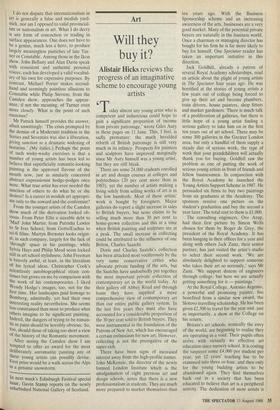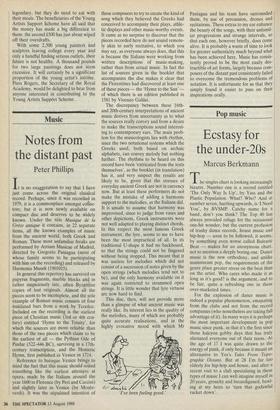Art
Will they buy it?
Alistair Hicks reviews the progress of an imaginative scheme to encourage young artists Today almost any young artist who is competent and industrious could hope to gain a significant proportion of income from private patronage,' wrote Giles Auty in these pages on 11 June. This, I feel, is sadly premature: the much heralded rebirth of British patronage is still very much in its infancy. Prospects for painters and sculptors have improved marginally since Mr Auty himself was a young artist, but they are still bleak.
There are some 24,000 students enrolled in art and design courses at colleges and polytechnics (20 per cent more than in 1983), yet the number of artists making a living solely from selling works of art is in the low hundreds. Most of these artists' work is bought by foreigners. Major galleries do report a slight increase in sales to British buyers, but none claims to be selling much more than 30 per cent to home-grown collectors and this at a time when British painting and sculpture are at a peak. The small increase in collecting could be attributed to the influence of one Briton, Charles Saatchi.
Doris and Charles Saatchi's collection has been attacked most vociferously by the very same conservative critics who advocate private funding of the arts, but the Saatchis have undoubedly put together the most important private collection of contemporary art in the world today. At their gallery off Abbey Road and through loans they have supplied a more comprehensive view of contemporary art than our entire public gallery system. In the last five years they must also have accounted for a considerable proportion of the 30 per cent sold to British buyers. They were instrumental in the foundation of the Patrons of New Art, which has encouraged a certain enthusiasm for new art. However, collecting is not the prerogative of the super-rich.
There have been signs of increased interest away from the high-profile names. John McKenzie, the director of the newly formed London Institute which is the amalgamation of eight previous art and design schools, notes that there is a new professionalism in students. They are much more prepared to market themselves than
ten years ago. With the Business Sponsorship scheme and an increasing awareness of the arts, businesses are a very good market. Many of the potential private buyers are naturally in the business world. Once a chairman or managing director has bought for his firm he is far more likely to buy for himself. One Spectator reader has taken an important initiative in this direction.
Jack Goldhill, already a patron of several Royal Academy scholarships, read an article about the plight of young artists in The Spectator four years ago. He was horrified at the stories of young artists a few years out of college being forced to give up their art and become plumbers, train drivers, house painters, shop fitters and market gardeners. There is much talk of a proliferation of galleries, but there is little hope of a young artist finding a serious gallery to take him on in the first ten years out of art school. There may be some 300 galleries in the Greater London area, but only a handful of them supply a steady diet of serious work, the type of work that your grandchildren will actually thank you for buying. Goldhill saw the problem as one of putting the work of serious young artists in front of friends and fellow businessmen. In conjunction with the Royal Academy he launched the Young Artists Support Scheme in 1987. He persuaded six firms to buy two paintings from six graduates at the Academy. The sponsors receive one picture on the student's graduation and buy the second a year later. The total cost to them is £1,000.
The consulting engineers, Ove Arup, had their first picture by Simon Wells chosen for them by Roger de Grey, the president of the Royal Academy. It has been hanging in their offices for a year and along with others Jack Zunz, their senior partner, has just visited the artist's studio to select their second work. 'We are absolutely delighted to support someone who takes their art so seriously,' says Mr Zunz. 'We support dozens of engineers through college, but here we are actually getting something for it — paintings.'
At the Royal College, Antonio Argenio, a powerful and promising painter, has benefited from a similar new award, the Slotovo travelling scholarship. He has been given £2,500 to travel for the year and, just as importantly, a show at the College on his return.
Britain's art schools, ironically the envy of the world, are beginning to realise they are operating in a void. Their pupils often arrive with virtually no effective art education since nursery school. It is costing the taxpayer some £4,000 per student per year, yet 12 years' teaching has to be crammed into three or four, and then only for the young budding artists to be abandoned again. They find themselves back out in a society that has been educated to believe that art is a peripheral activity. The dedication of most artists is legendary, but they do need to eat with their meals. The beneficiaries of the Young Artists Support Scheme have all said that the money has made a big difference to them: the second £500 has just about wiped off their overdrafts.
With some 2,500 young painters and sculptors leaving college every year and only a handful finding serious outlets, their future is not healthy. A thousand pounds for two large paintings does not seem excessive. It will certainly be a significant proportion of the young artist's income. Piers Rogers, the Secretary of the Royal Academy, would be delighted to hear from anyone interested in contributing to the Young Artists Support Scheme.























































 Previous page
Previous page